
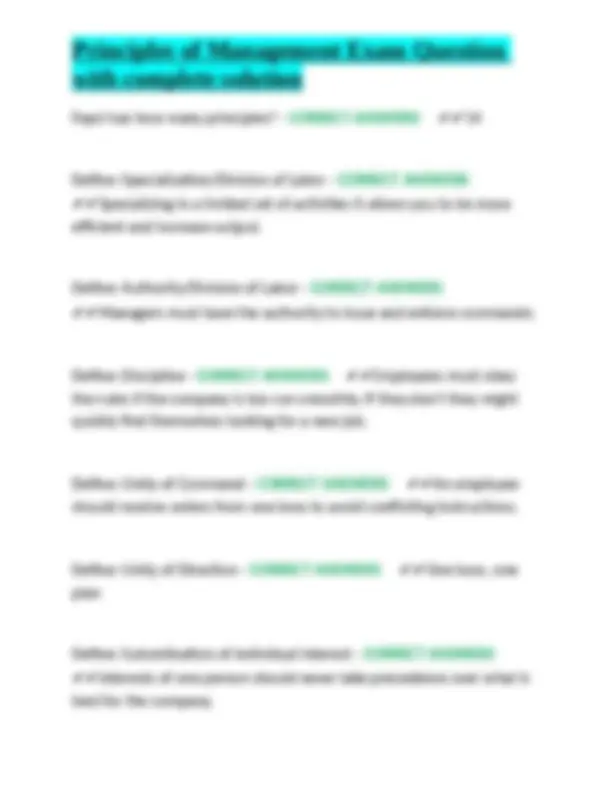
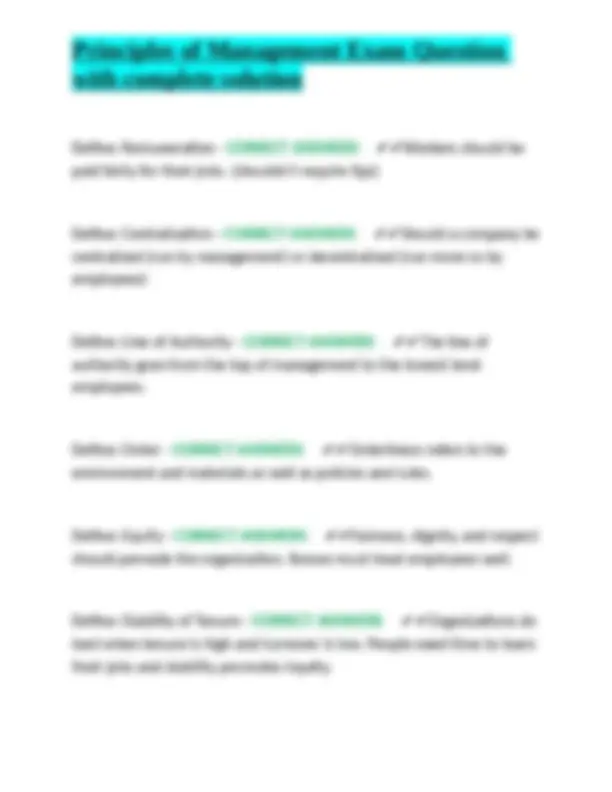
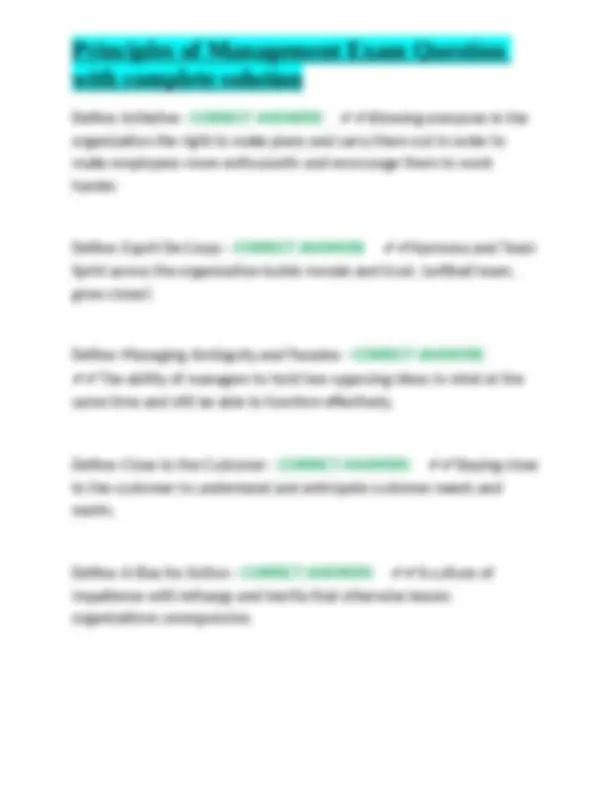
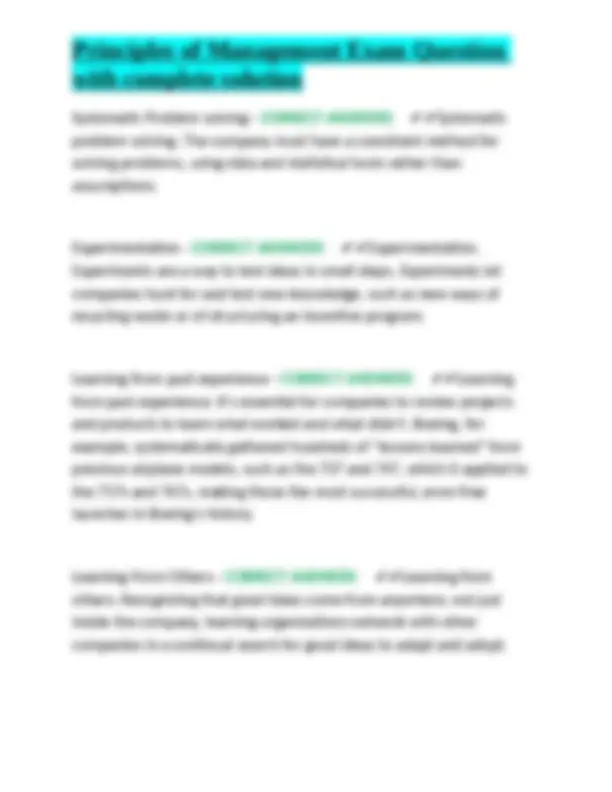
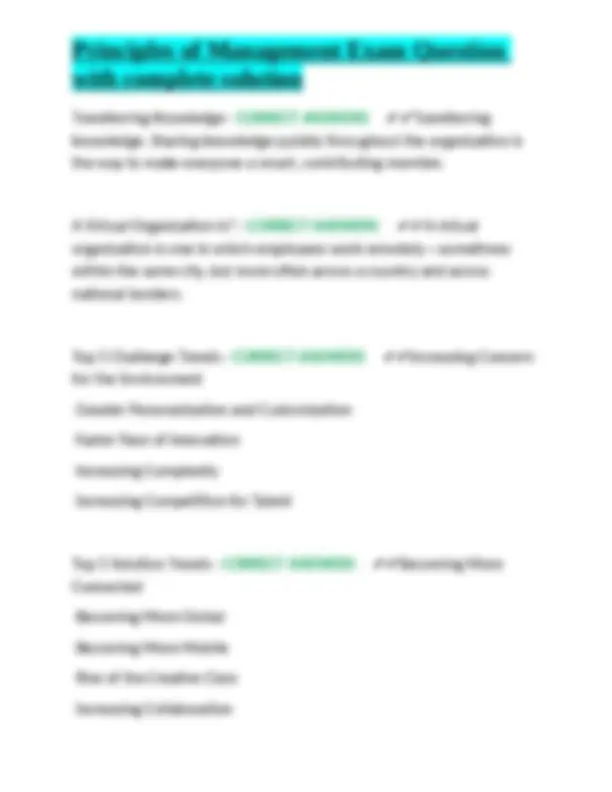
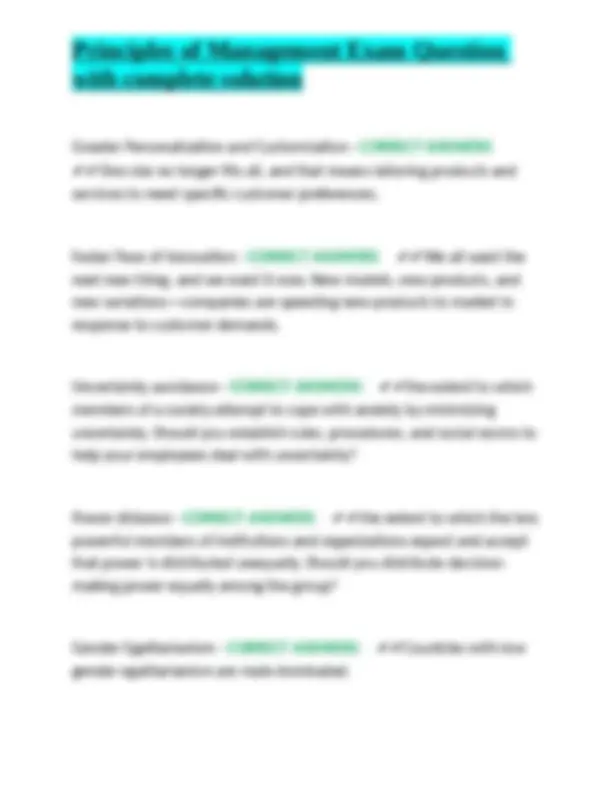
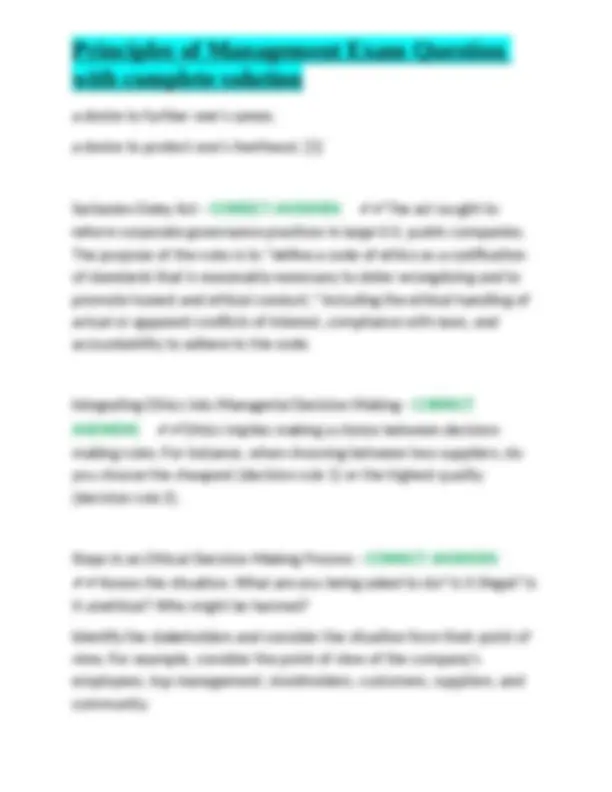
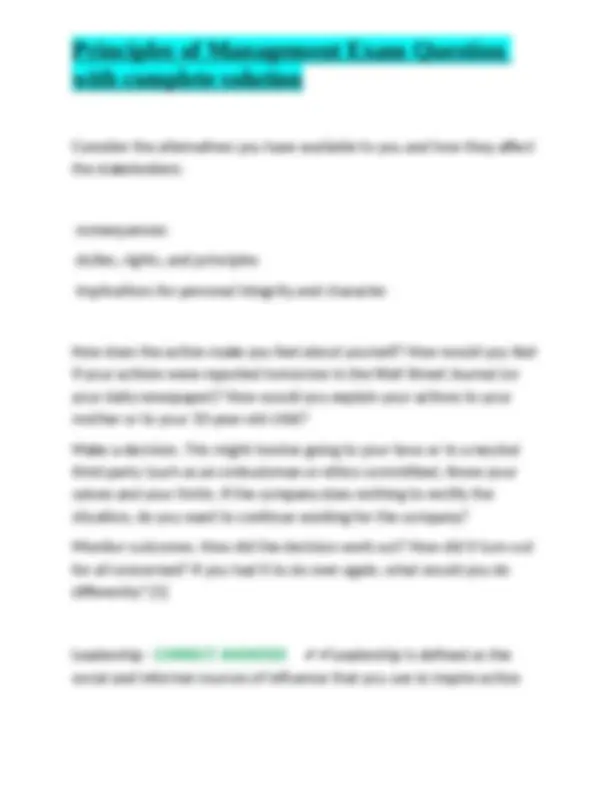
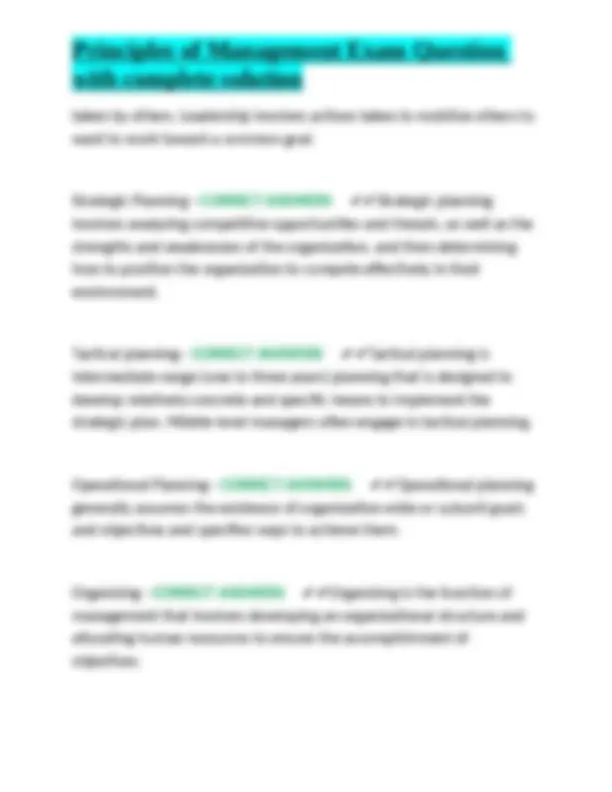
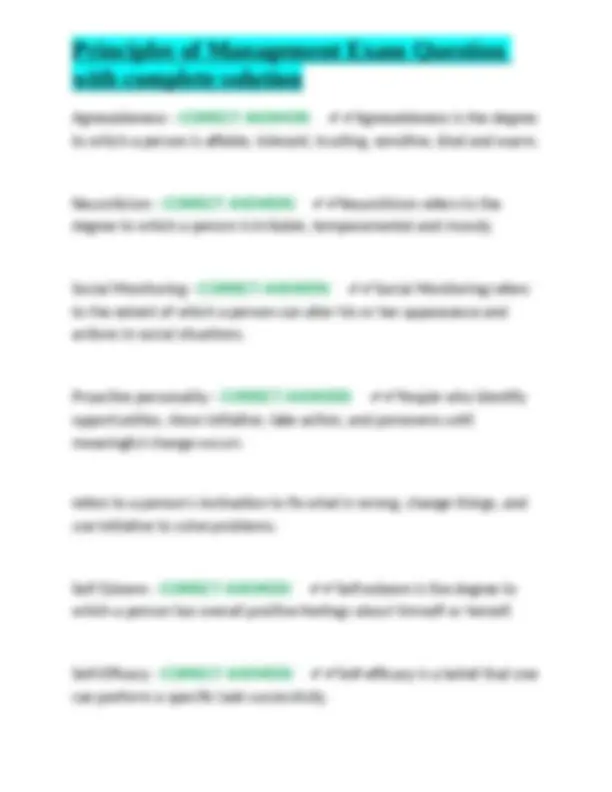
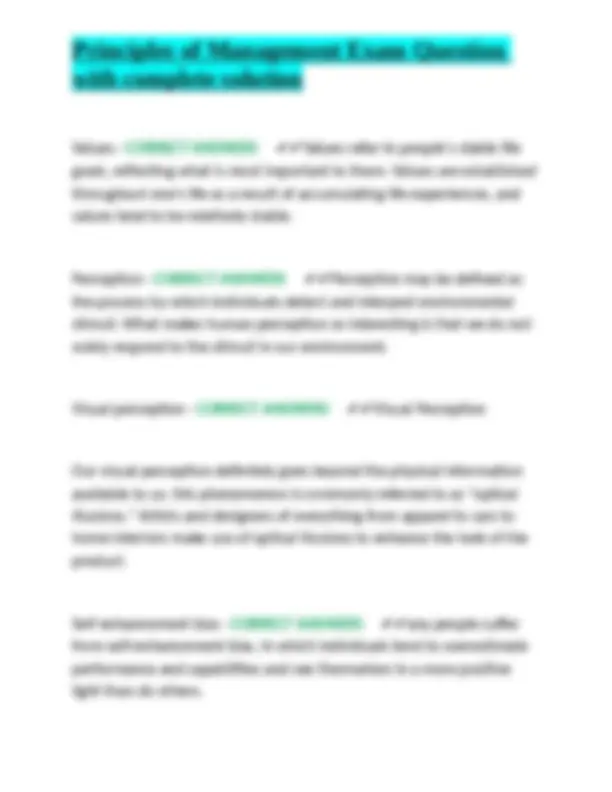
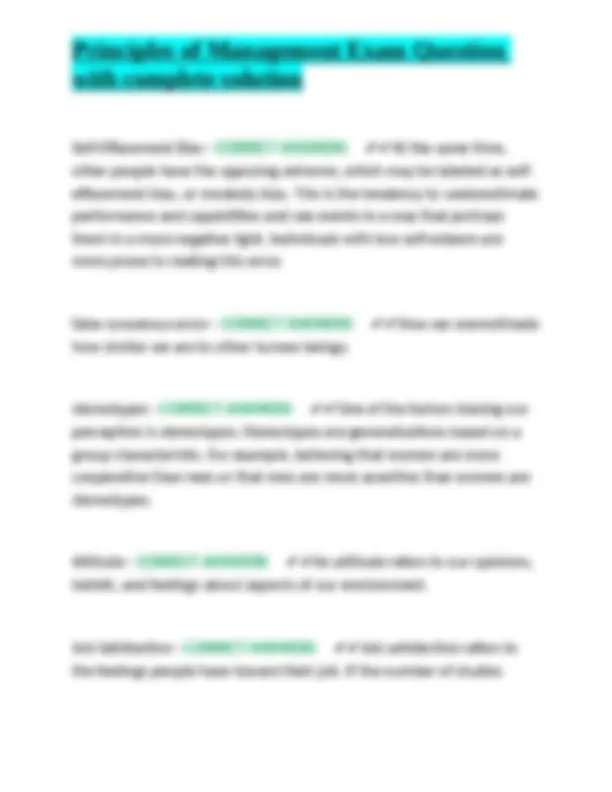
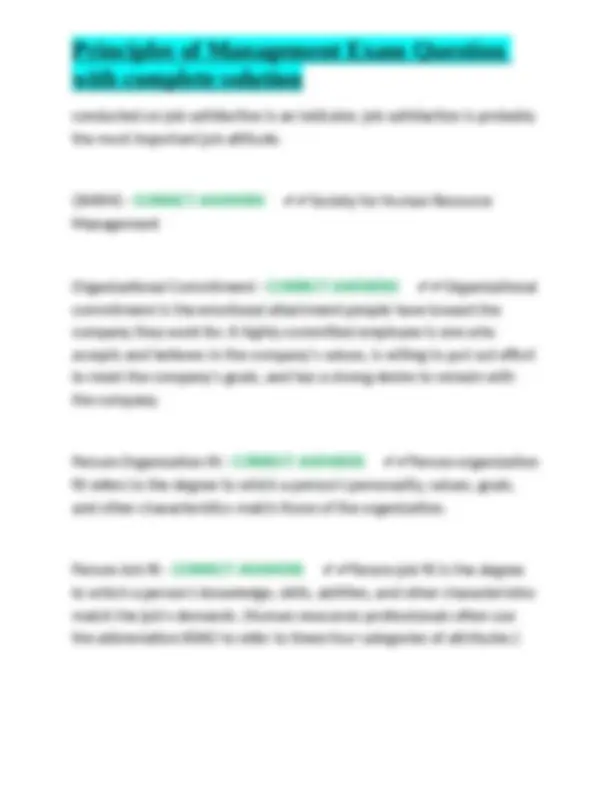
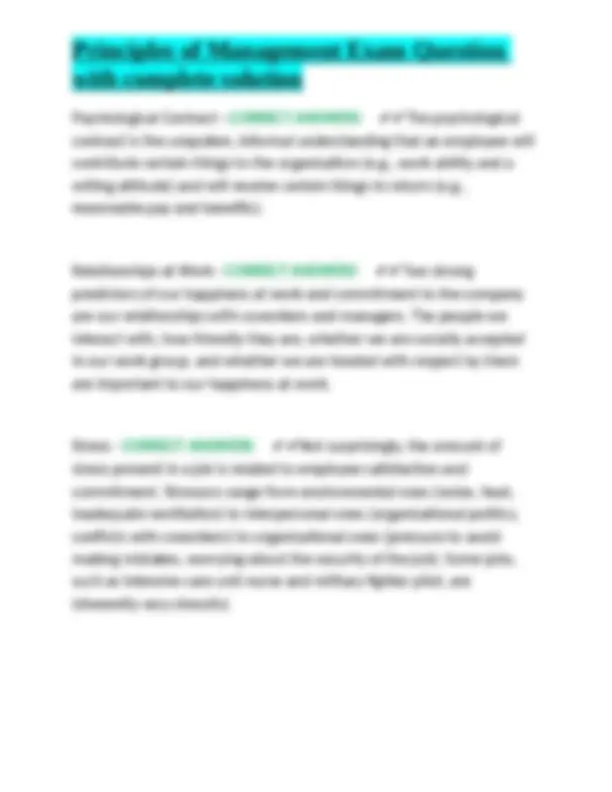
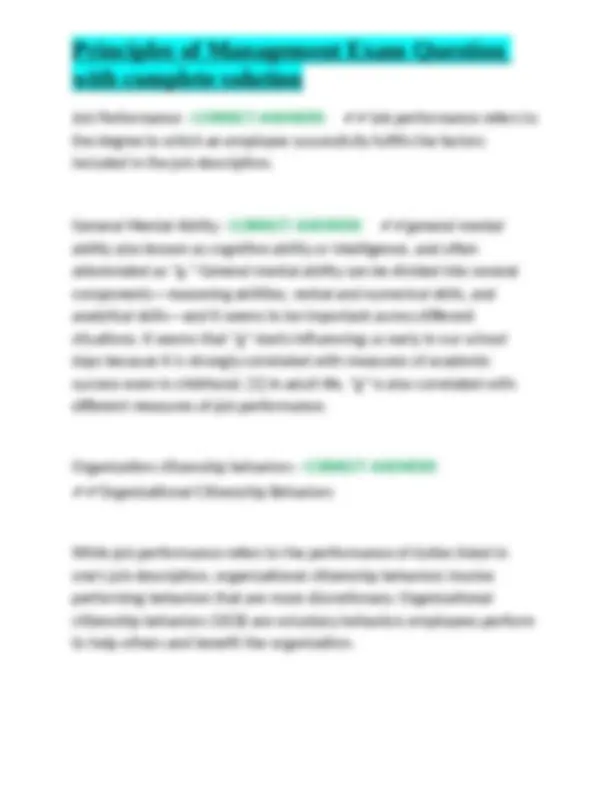
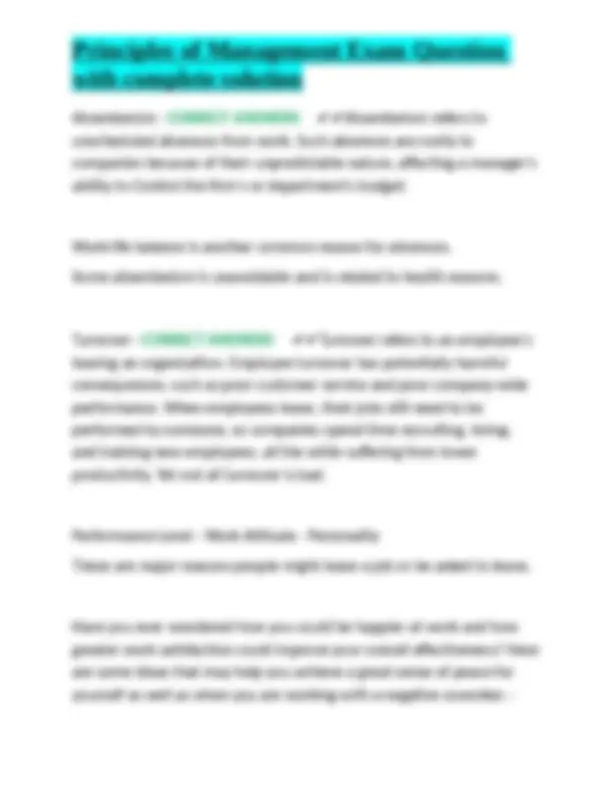
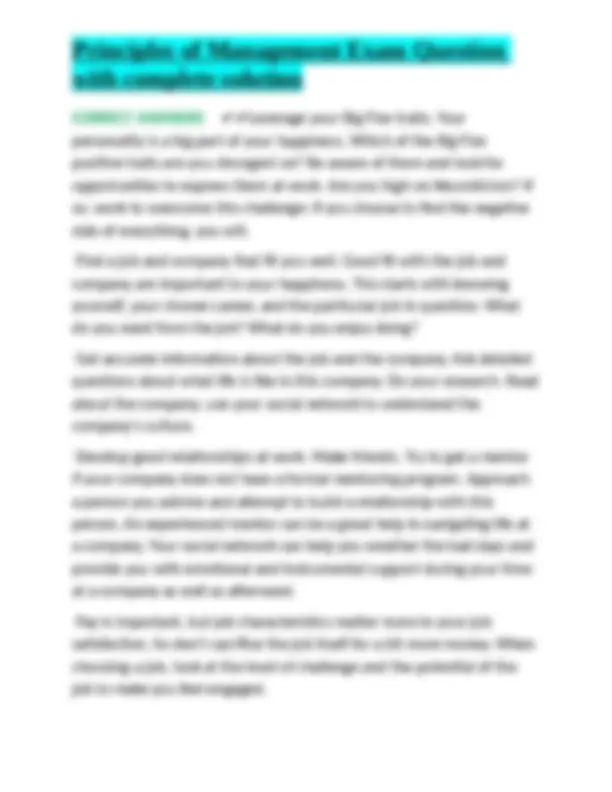
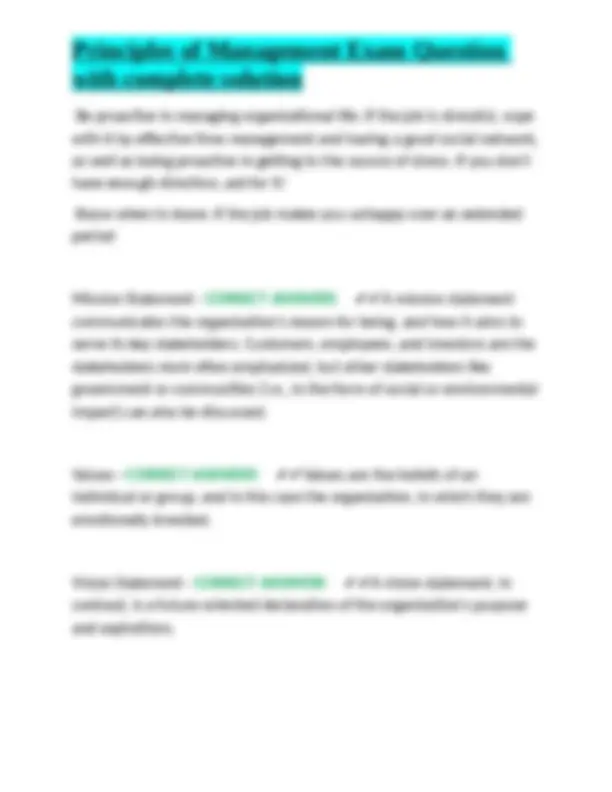
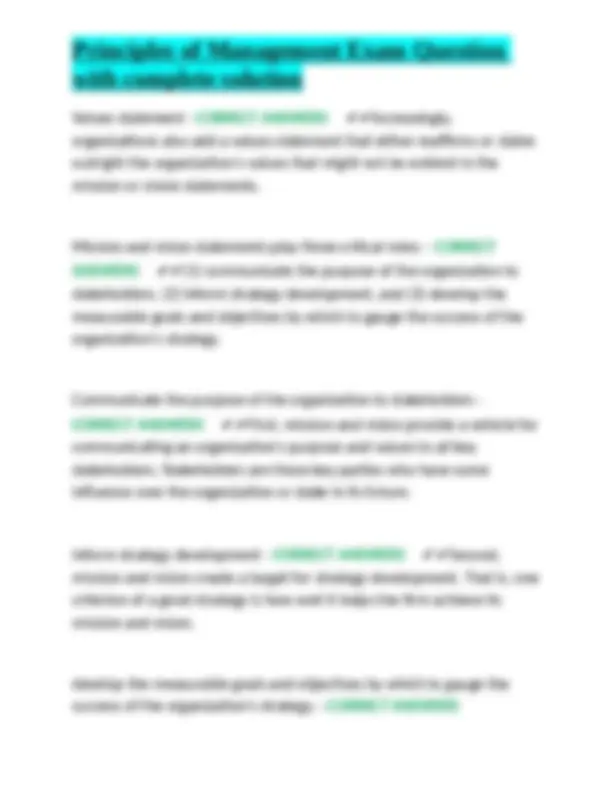
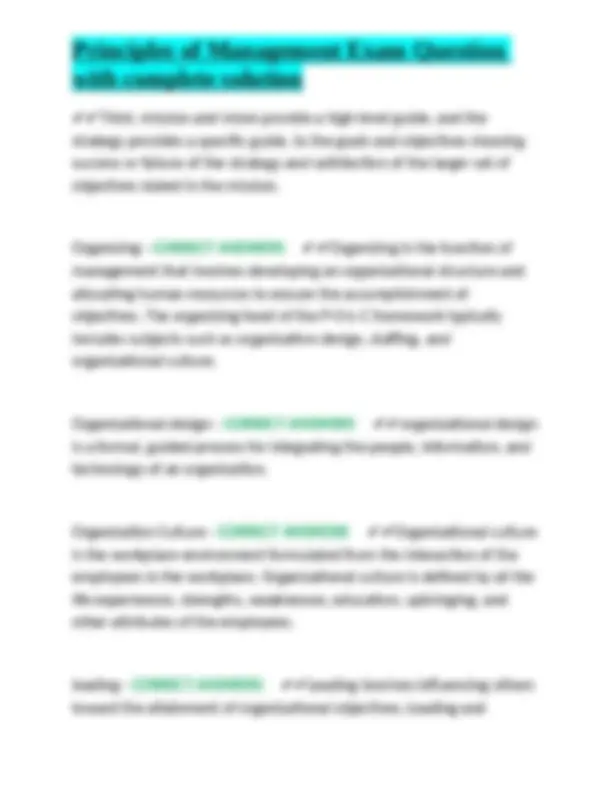
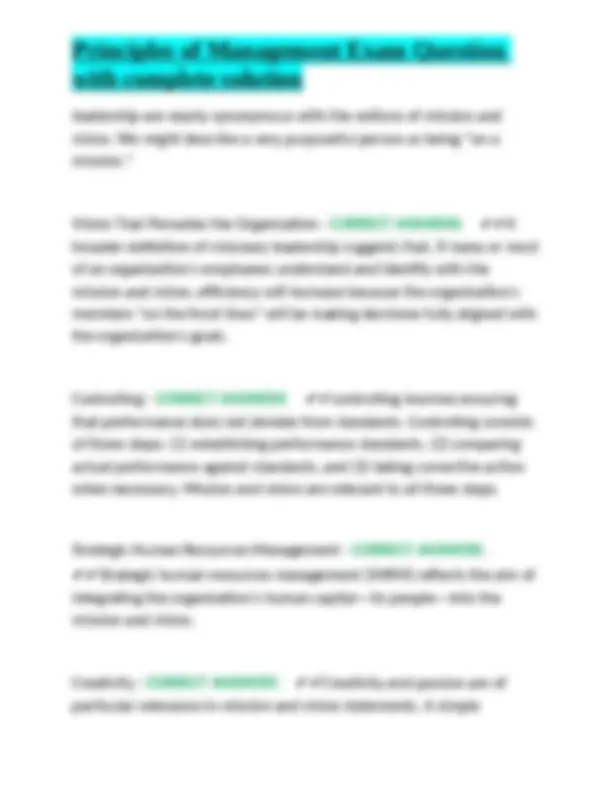
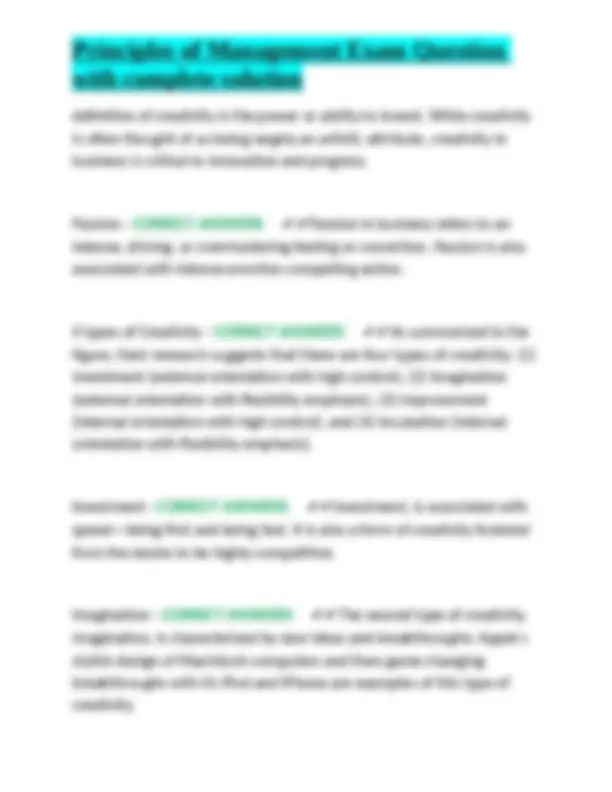
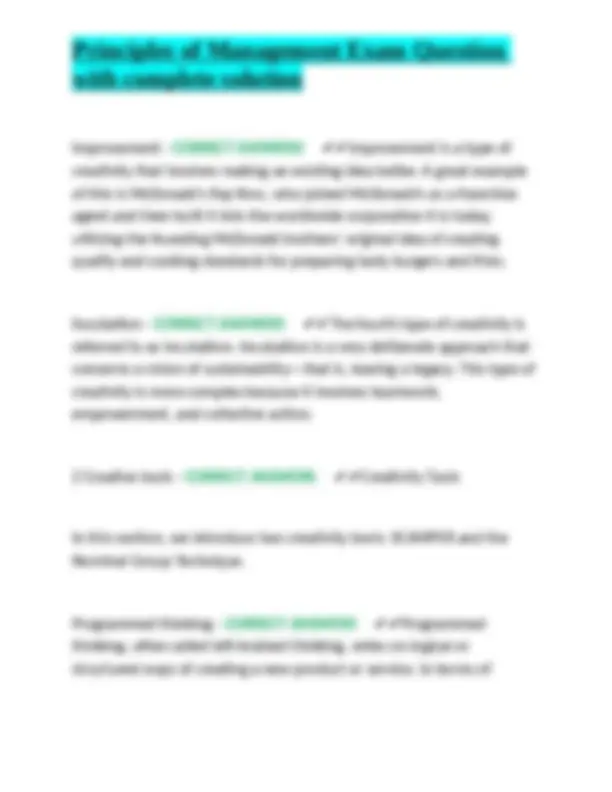
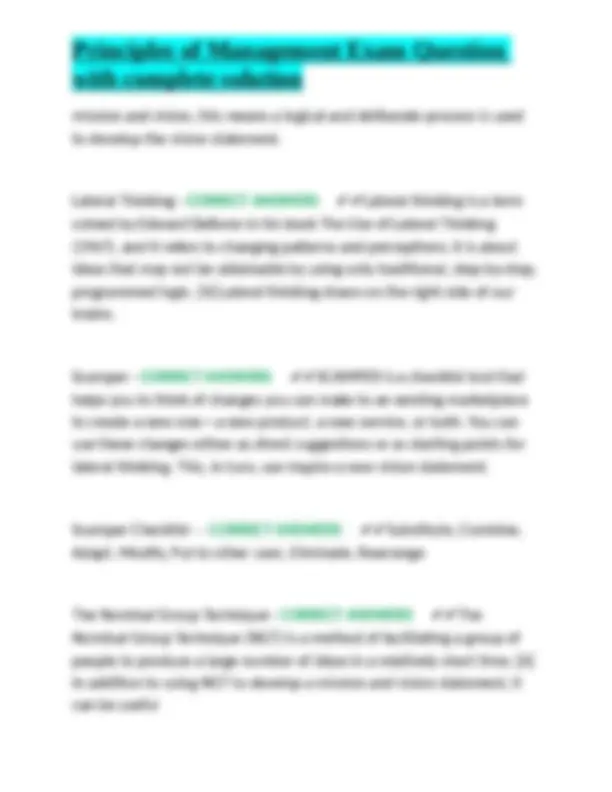
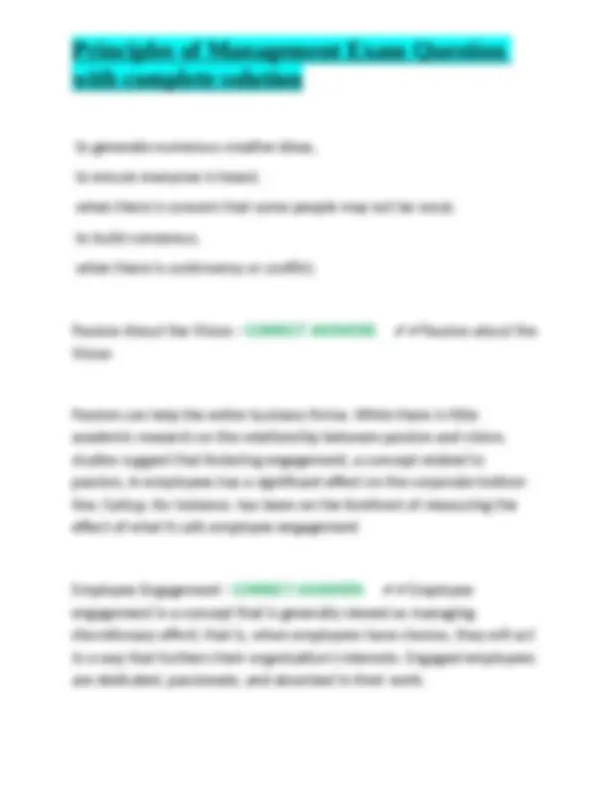
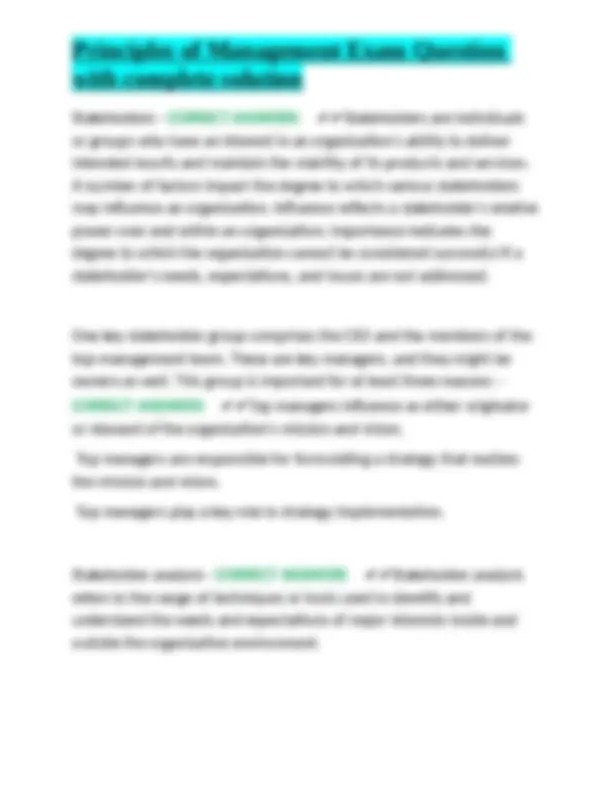
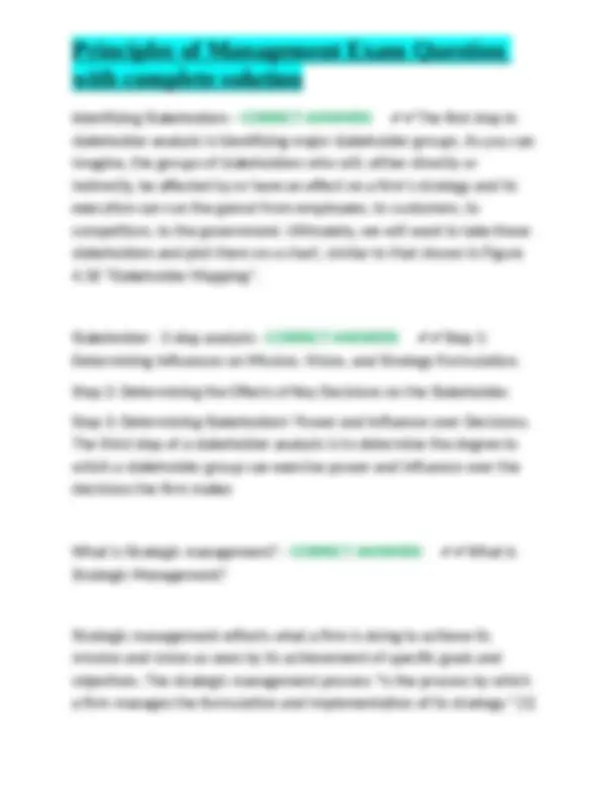
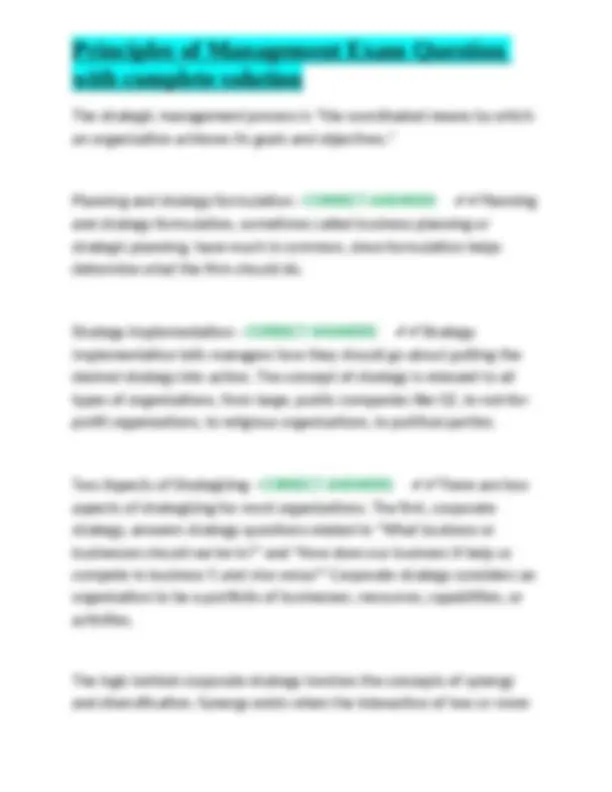
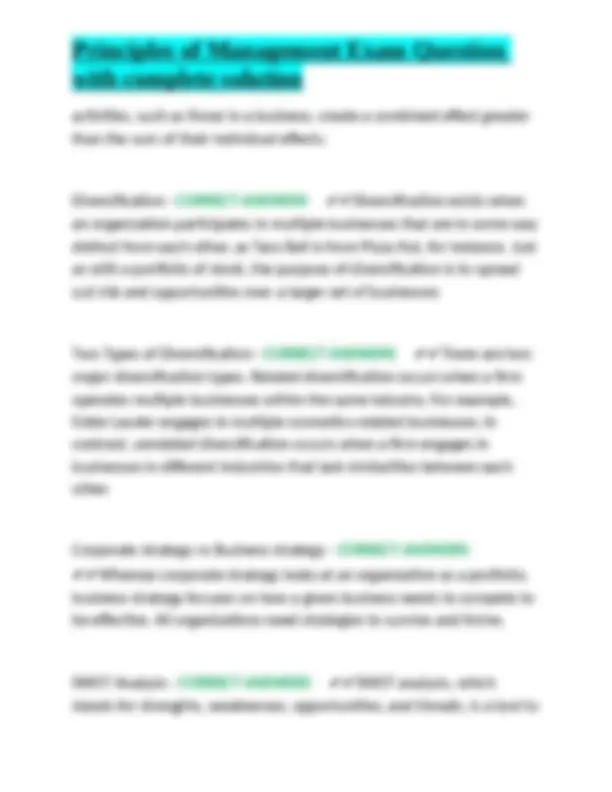
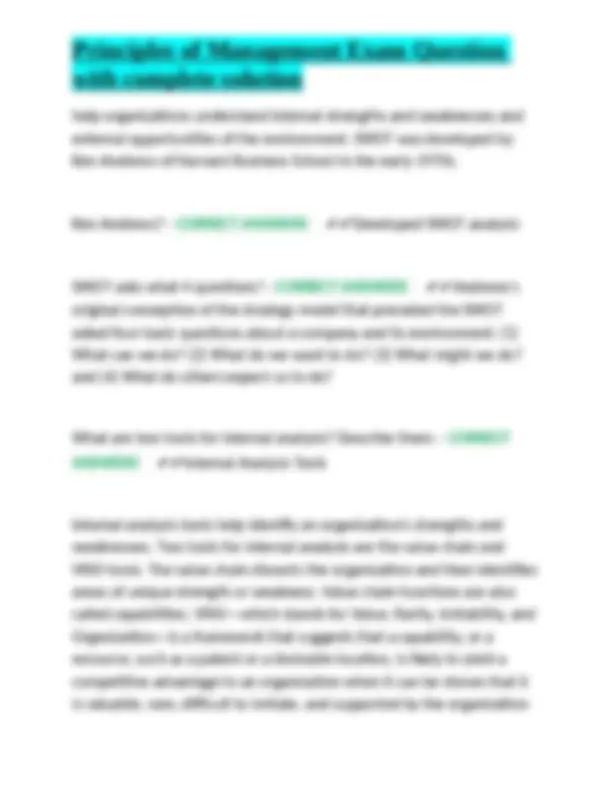
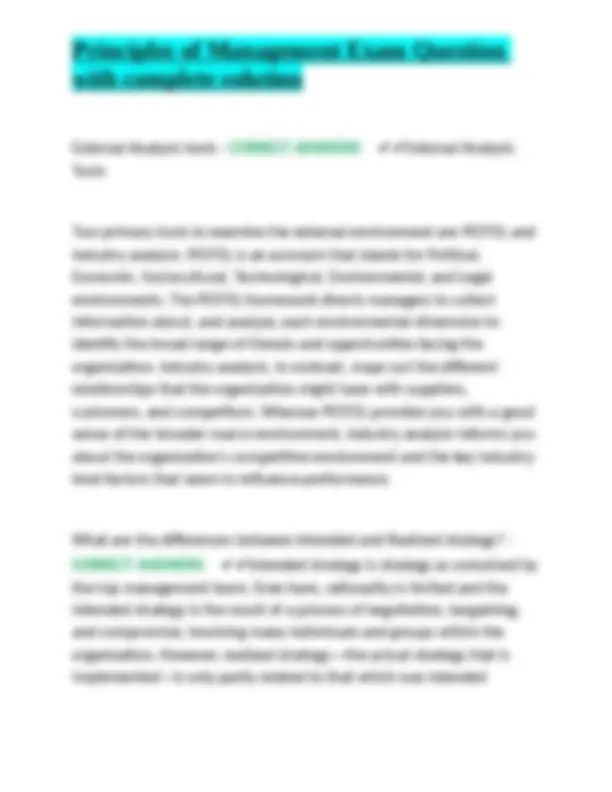
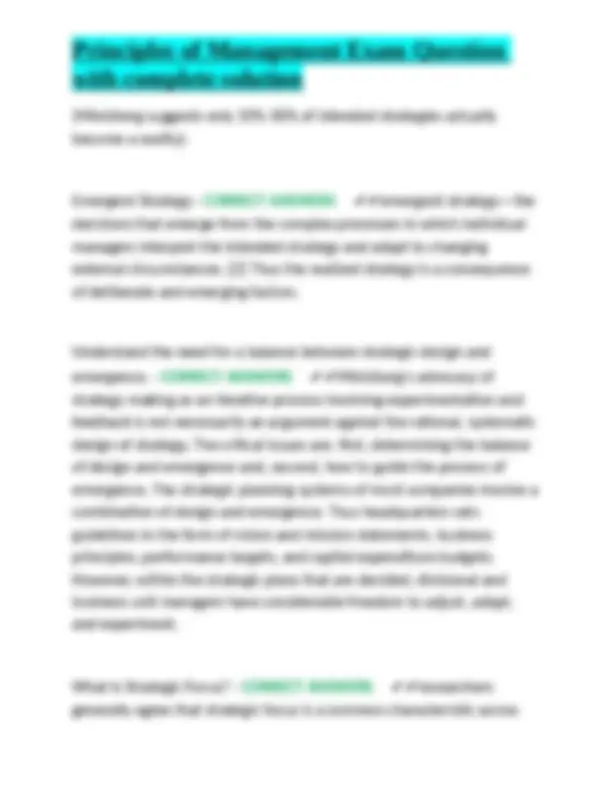
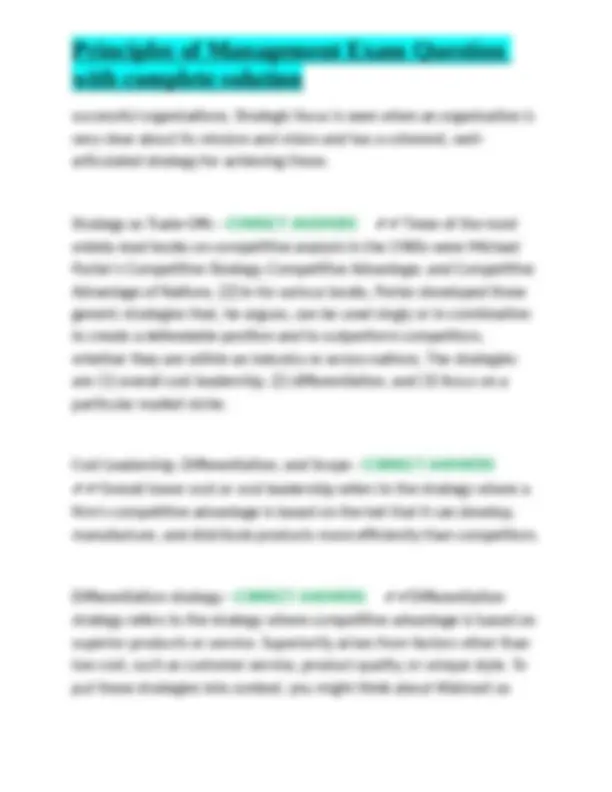
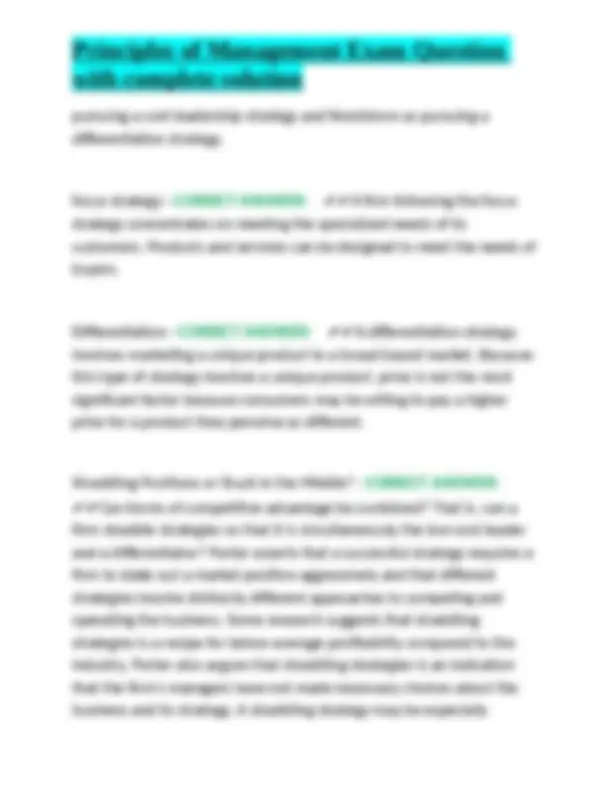
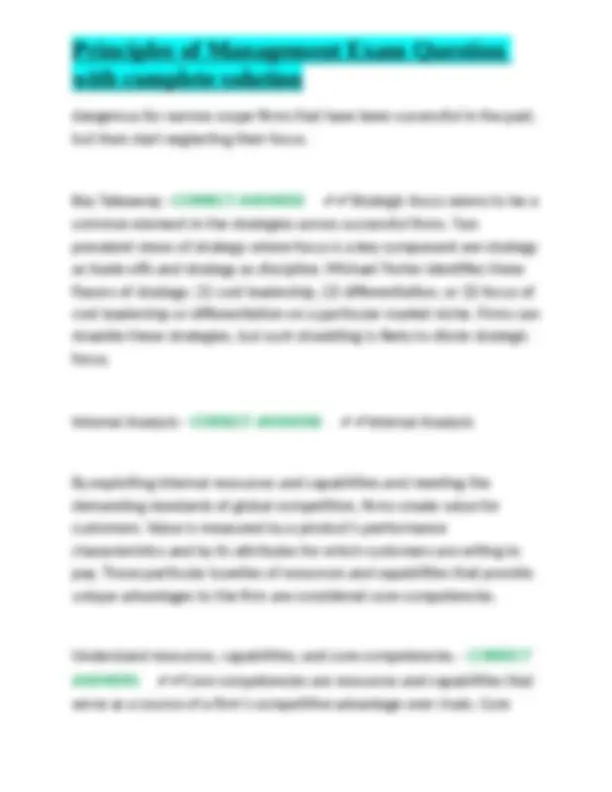
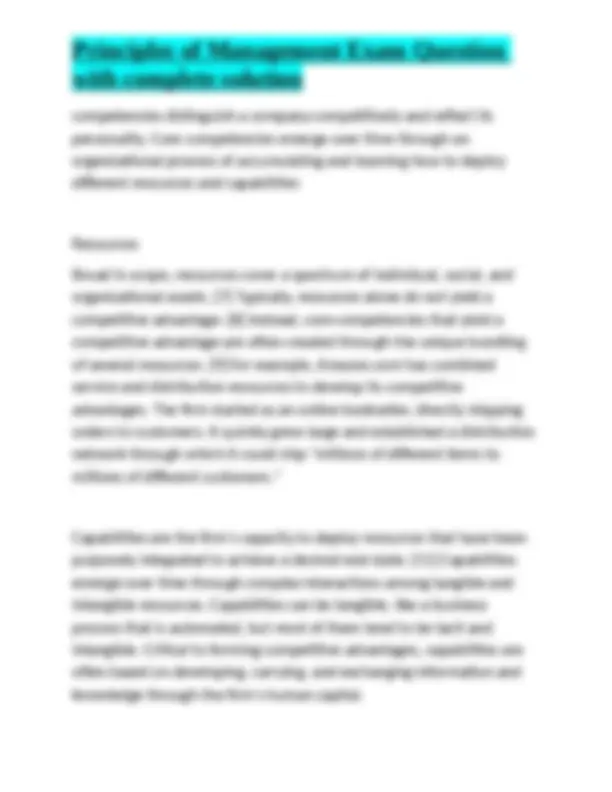
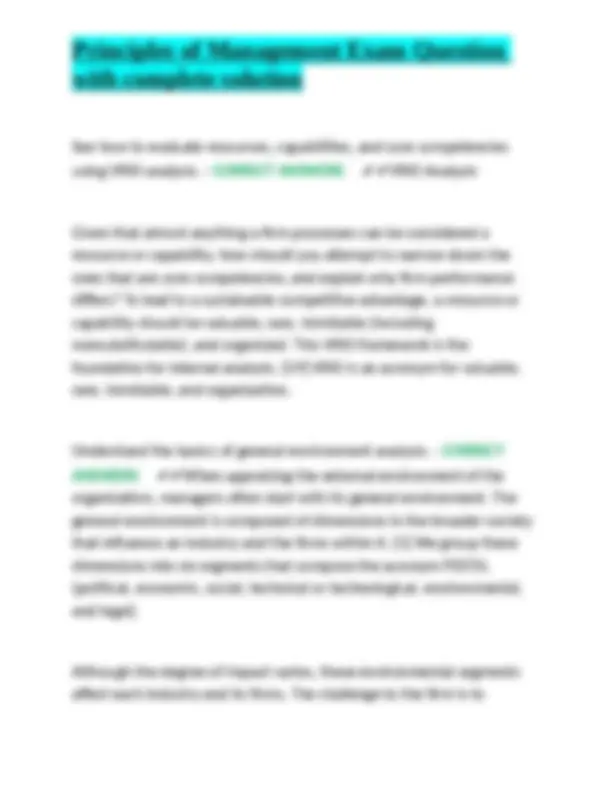
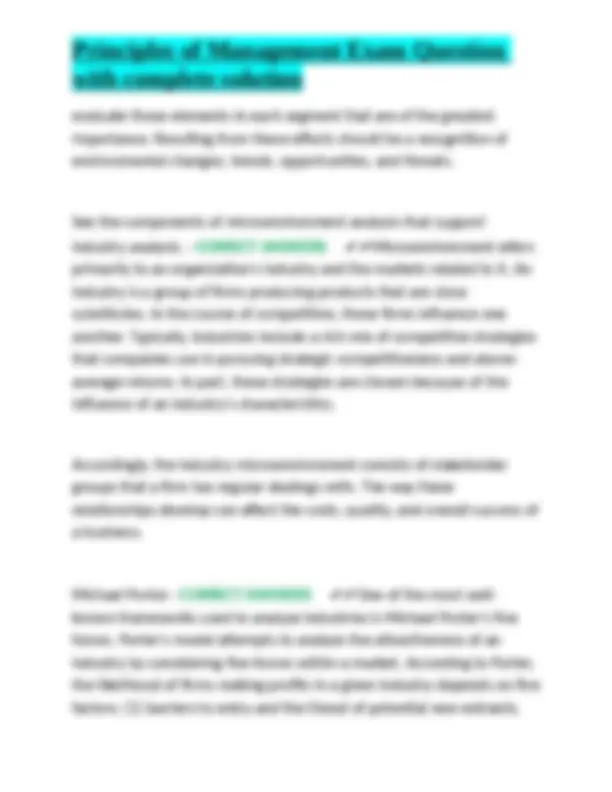
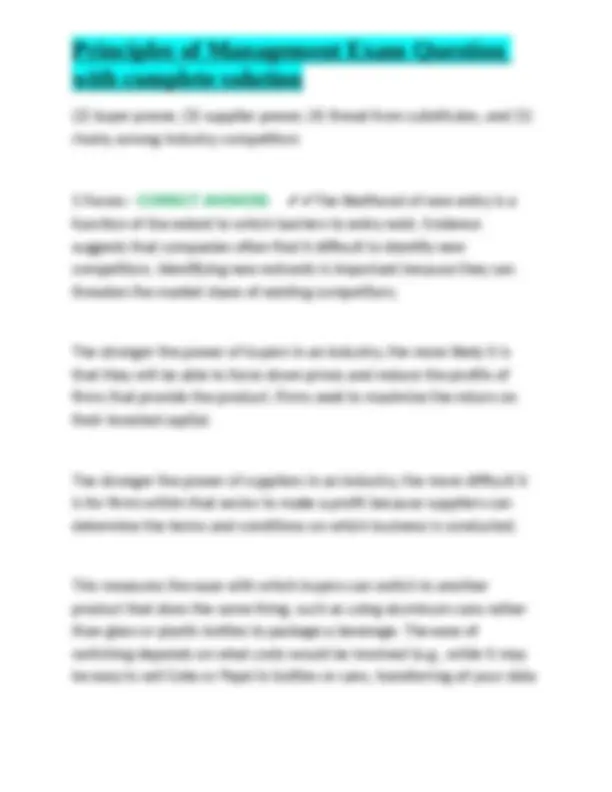
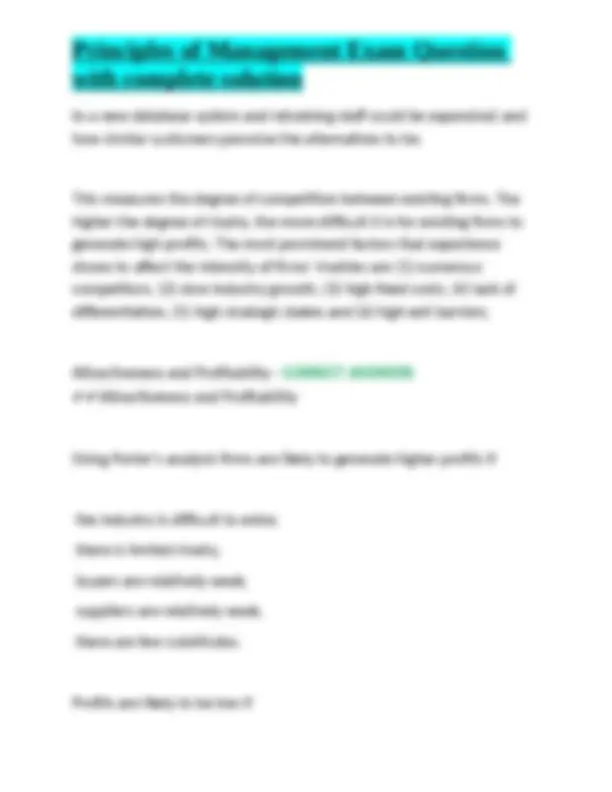
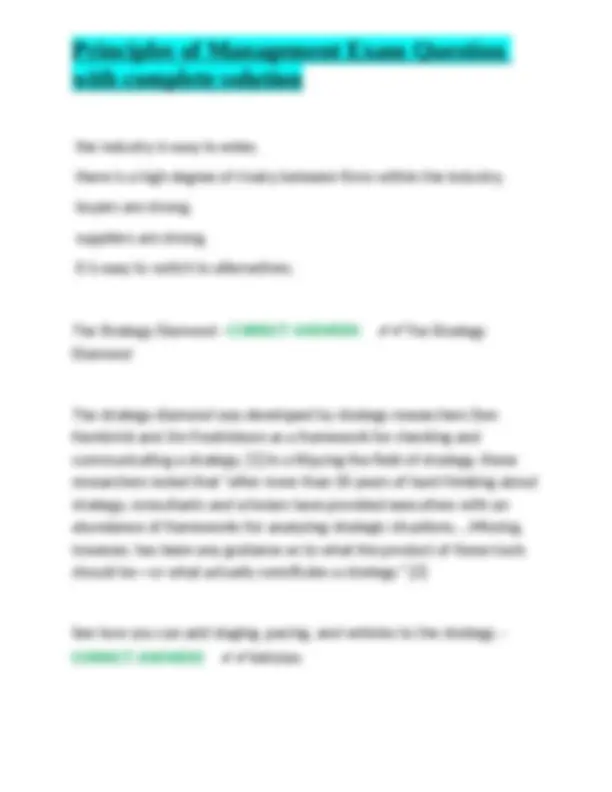
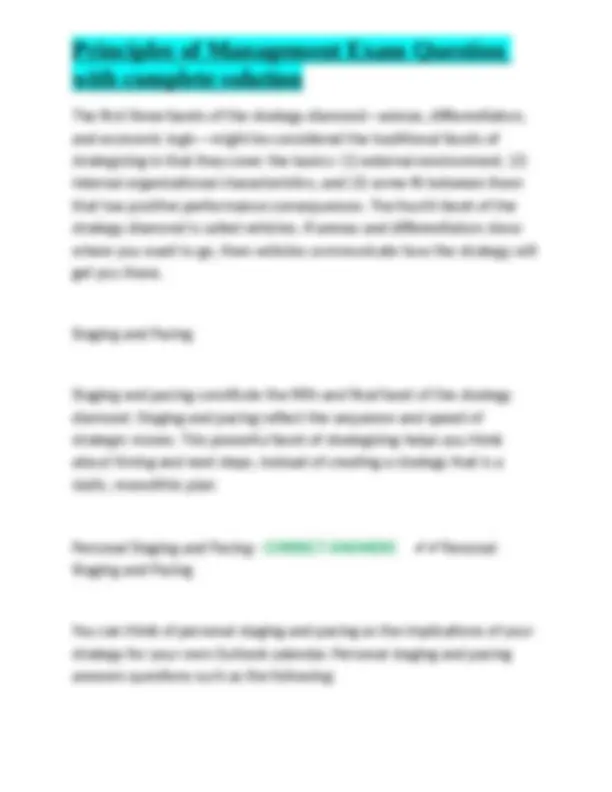
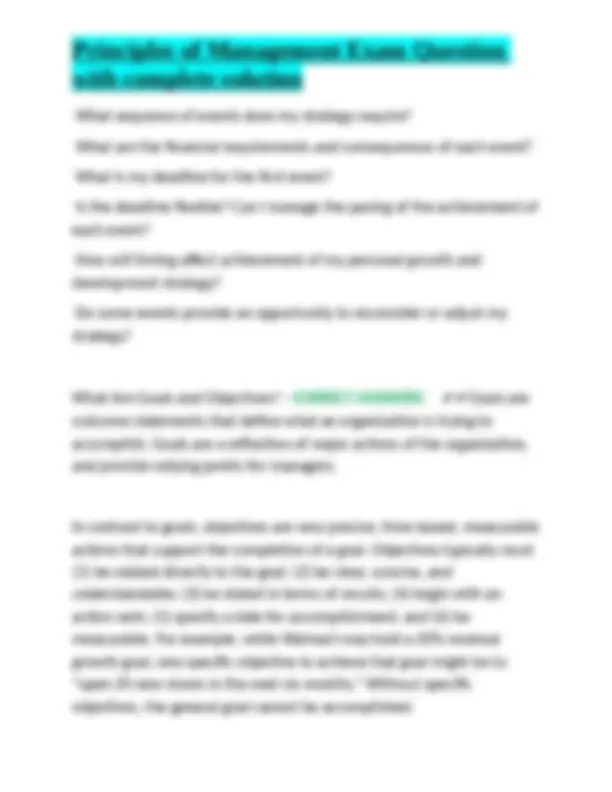
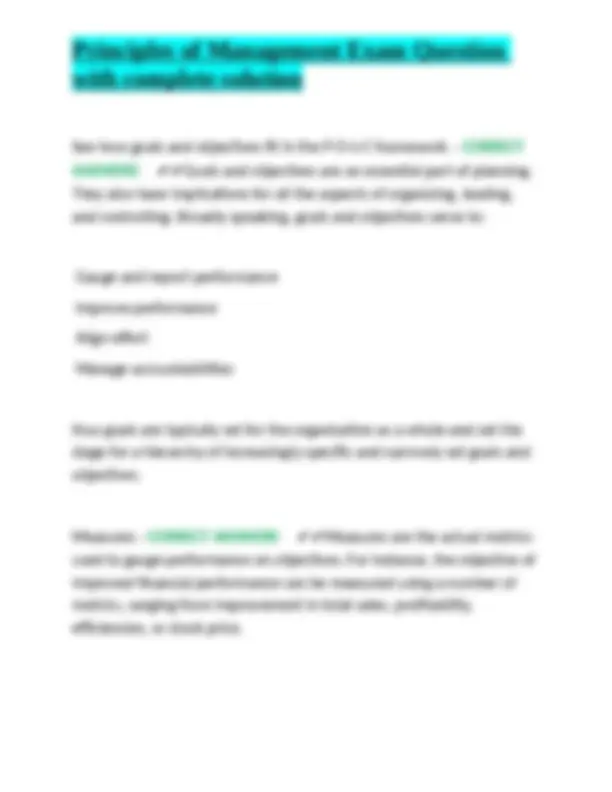
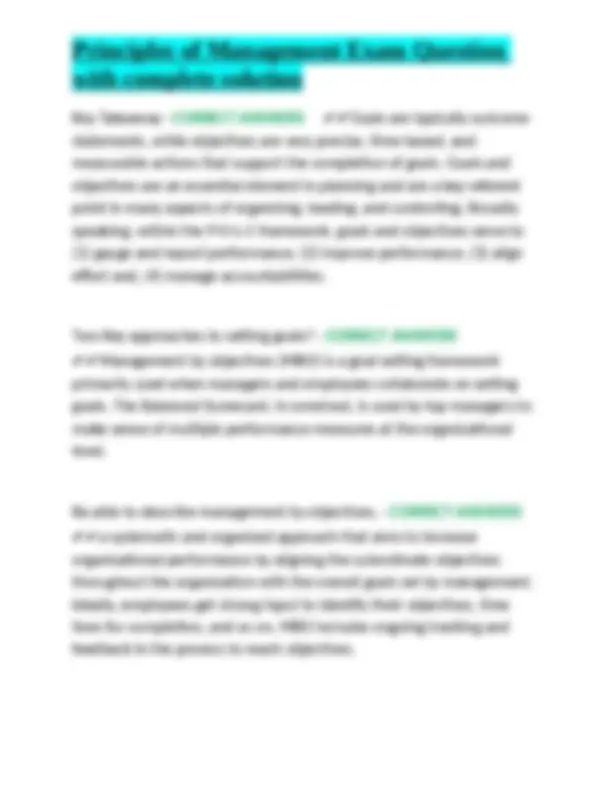
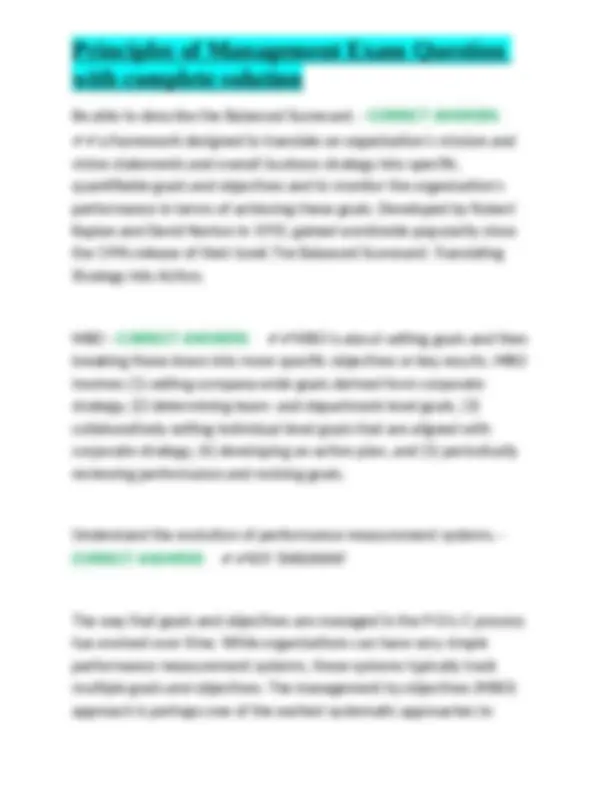
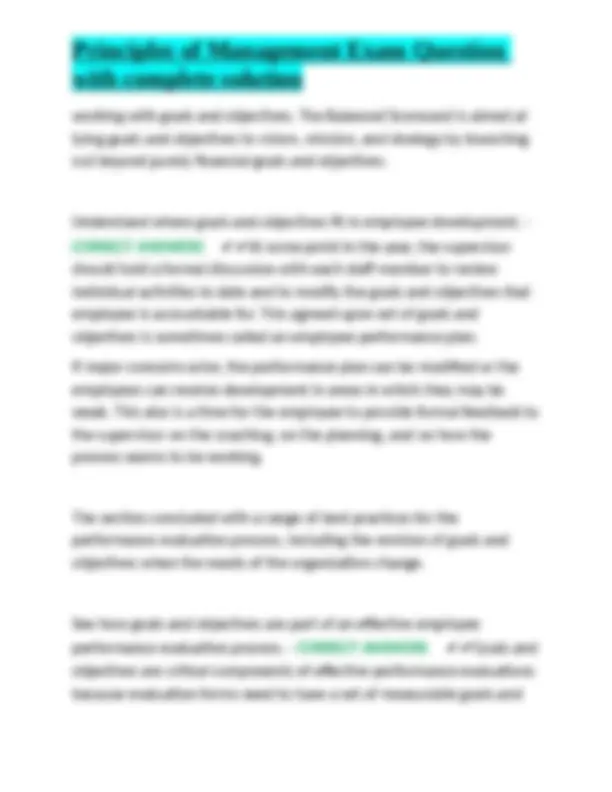
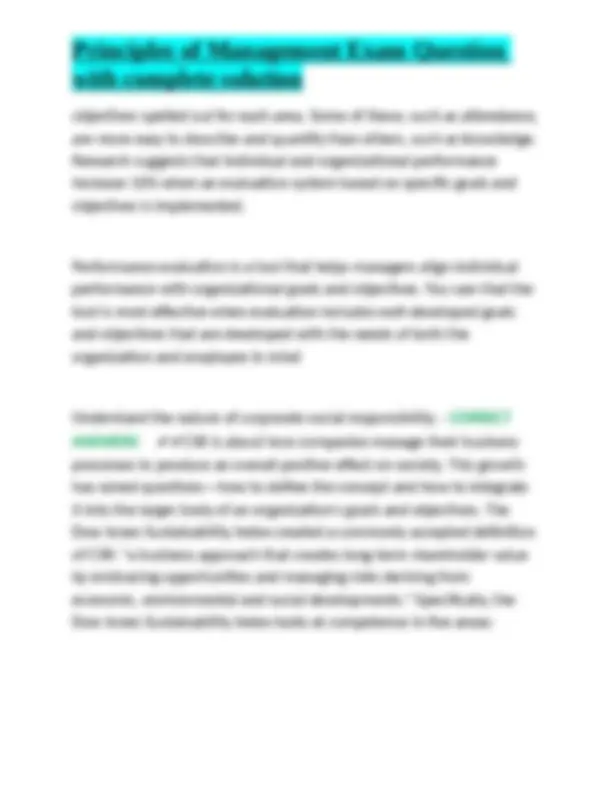
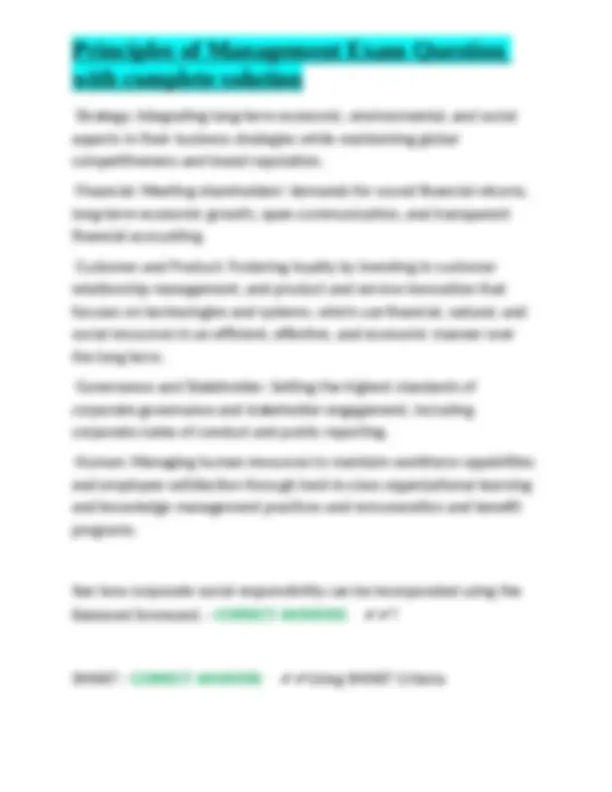
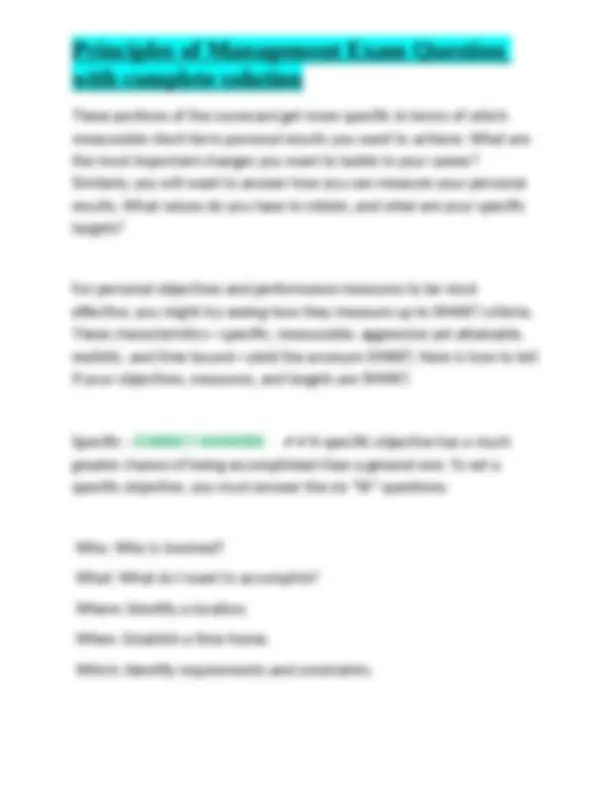
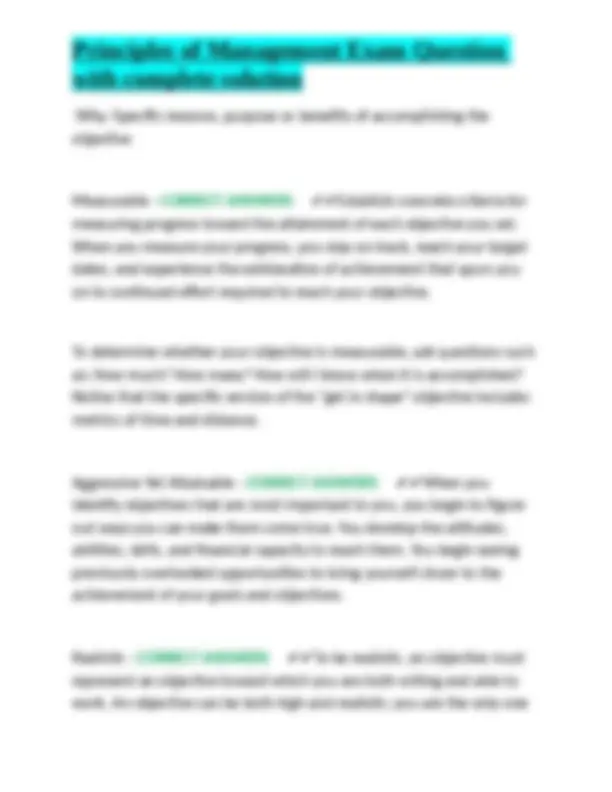
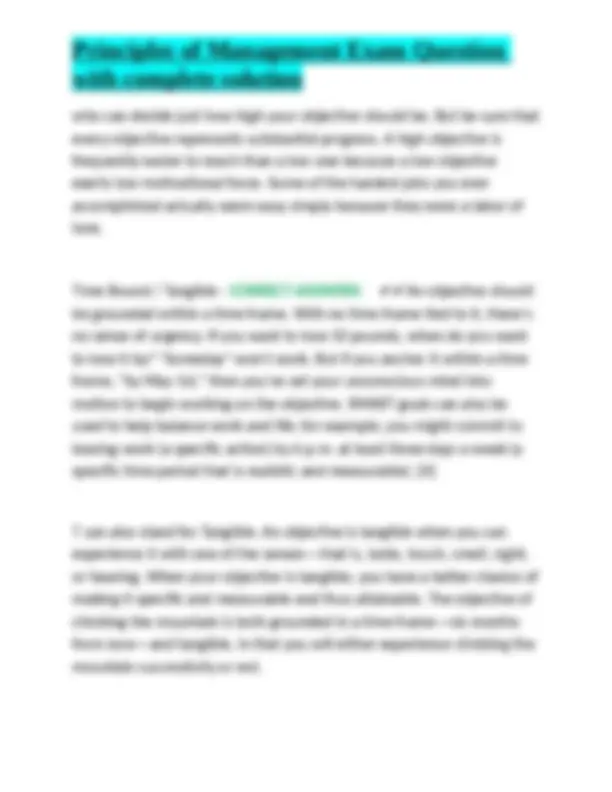
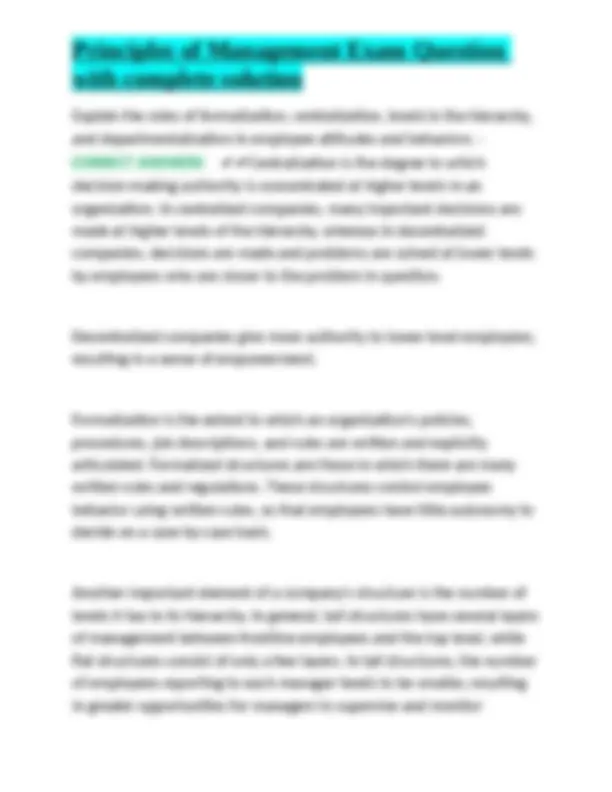
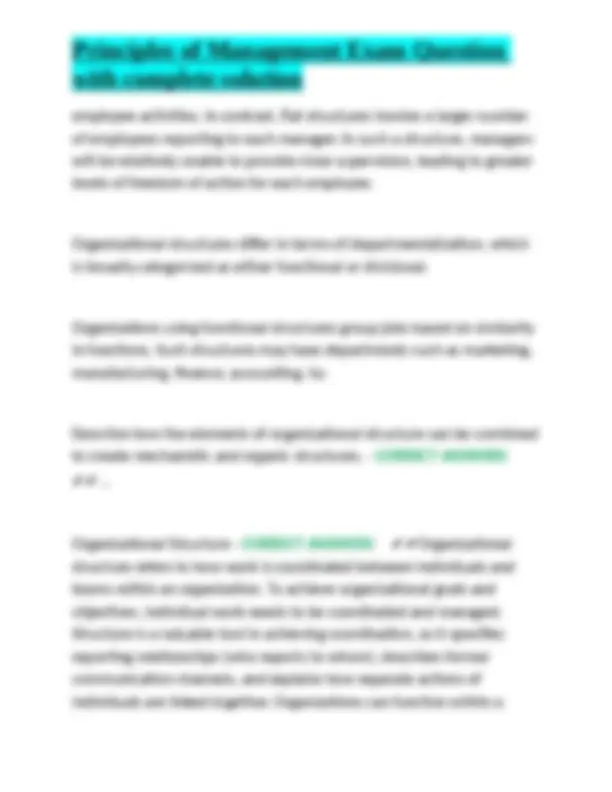
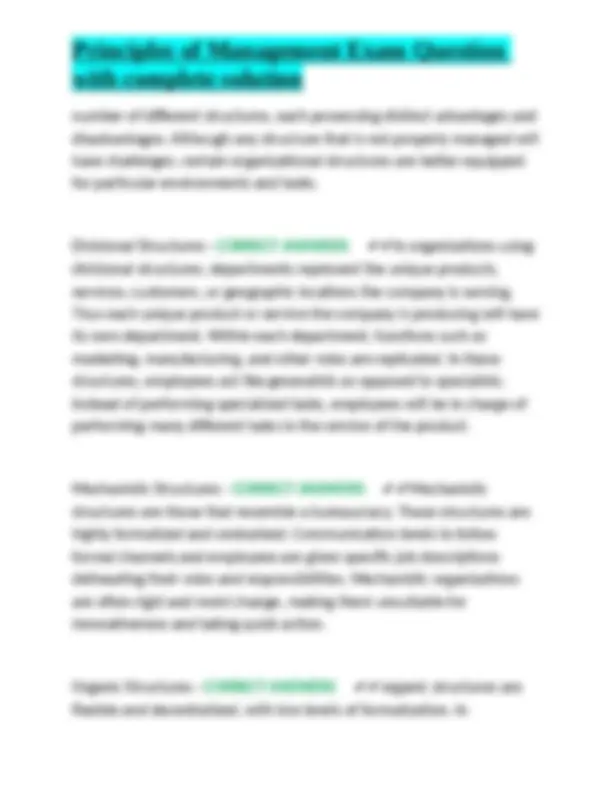

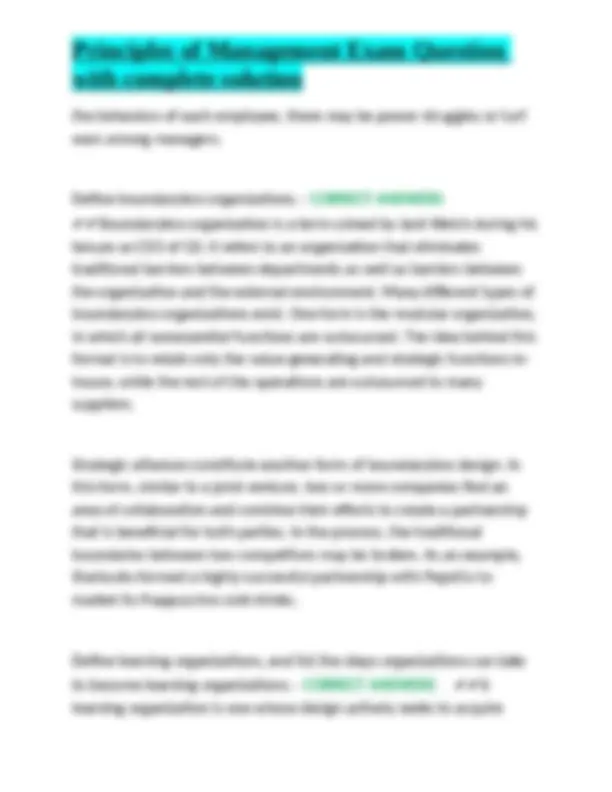
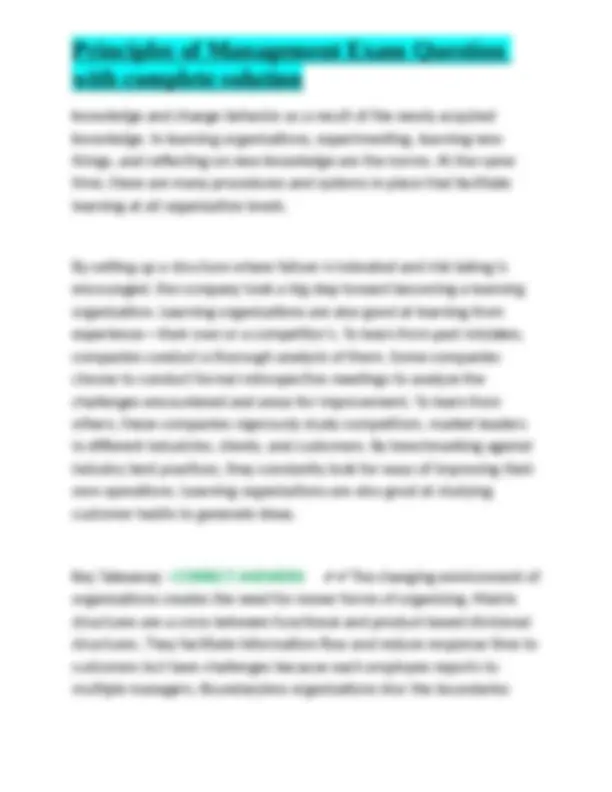
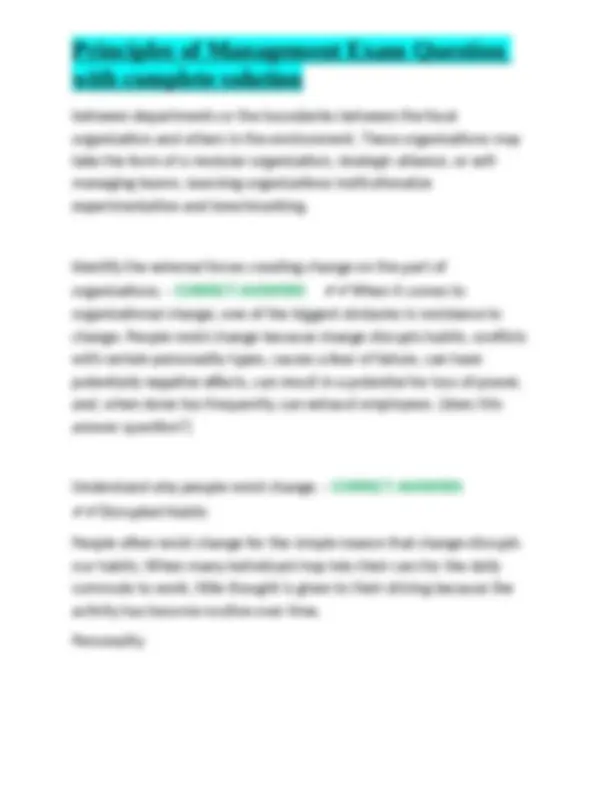
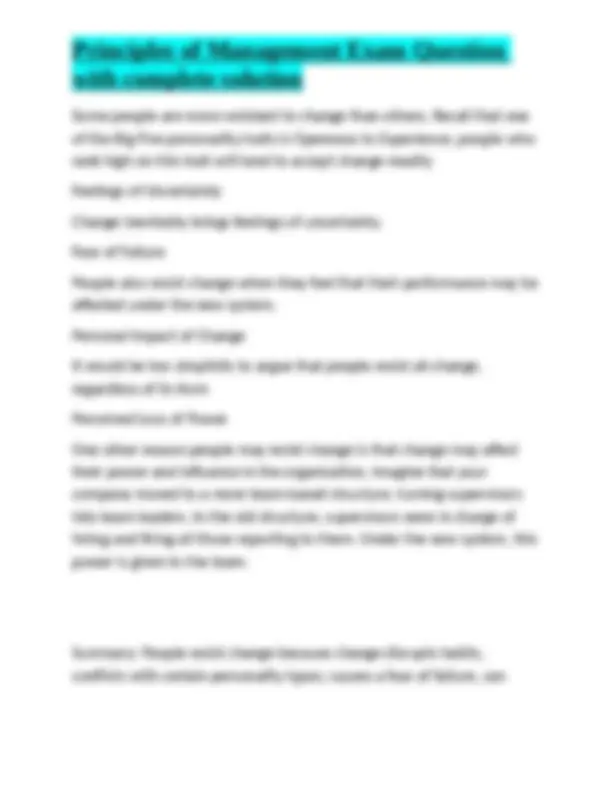
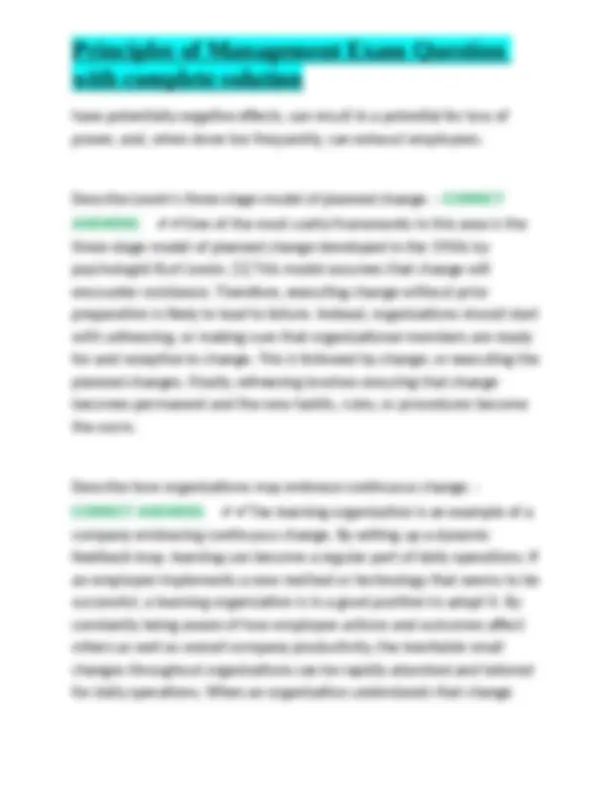
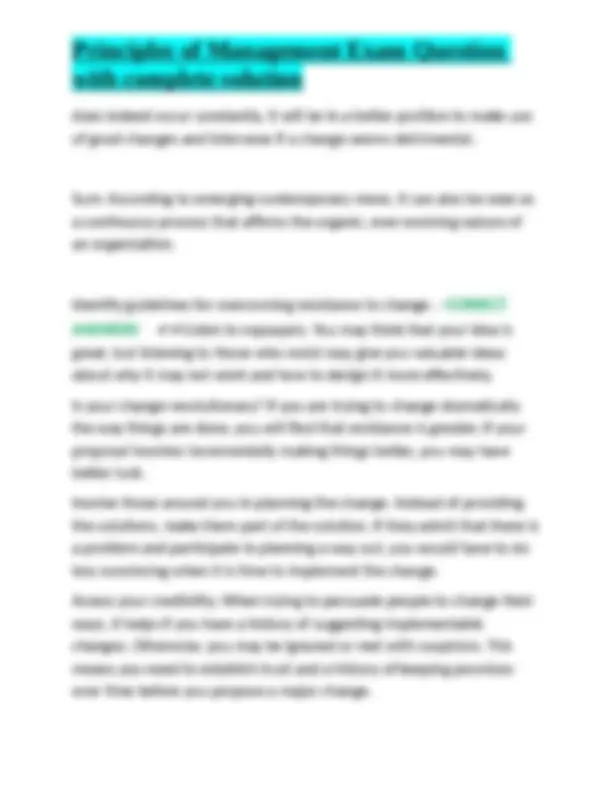
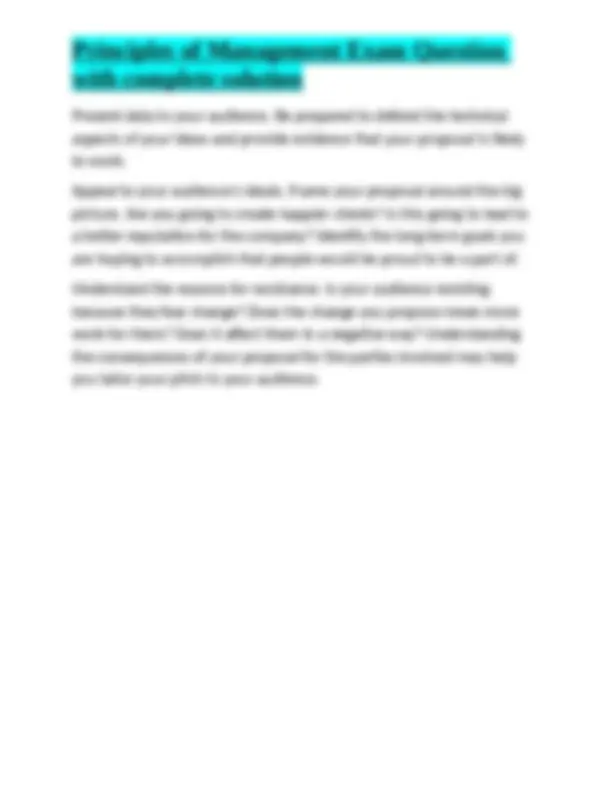


Study with the several resources on Docsity

Earn points by helping other students or get them with a premium plan


Prepare for your exams
Study with the several resources on Docsity

Earn points to download
Earn points by helping other students or get them with a premium plan
Community
Ask the community for help and clear up your study doubts
Discover the best universities in your country according to Docsity users
Free resources
Download our free guides on studying techniques, anxiety management strategies, and thesis advice from Docsity tutors
Principles of Management Exam Question with complete solution
Typology: Exams
1 / 71

This page cannot be seen from the preview
Don't miss anything!
































































What is a group? - CORRECT ANSWERS ✔✔A group is a collection of individuals What is a team? - CORRECT ANSWERS ✔✔A team is a cohesive coalition of people working together to achieve the team agenda (i.e., teamwork). Define: In Role Performance - CORRECT ANSWERS ✔✔Individual- level performance draws upon those things you have to do in your job, or in-role performance, Define: Extra-role Performance or Organizational Citizenship behaviors - CORRECT ANSWERS ✔✔Those things that add value but are not part of a formal job description. These "extras" are called extra-role performance, or organizational citizenship behaviors (OCBs). Seven common themes of extra-role performance - CORRECT ANSWERS ✔✔(1) Helping Behavior, (2) Sportsmanship, (3) Organizational Loyalty, (4) Organizational Compliance, (5) Individual Initiative, (6) Civic Virtue, and (7) Self-Development.
What is a Visual learner? - CORRECT ANSWERS ✔✔If you notice that you retain more information by reading and seeing diagrams and flow charts, you may be a visual learner. Define: Auditory Learner - CORRECT ANSWERS ✔✔Learn by listening to others, such as in lectures, conversations, and videos Define: kinesthetic learner. - CORRECT ANSWERS ✔✔you have a preference for actually doing things and learning from trial and error, you may be a kinesthetic learner. Gauge-Discover-Reflect - CORRECT ANSWERS ✔✔The three essential components are (1) gauge—take stock of your knowledge and capabilities about a topic; (2) discover—learn enough about a topic so that you can set specific development goals that you can apply and practice, and later gauge again your progress toward your set goals; and (3) reflect—step back and look at the ways you have achieved your goals, take the opportunity to set new ones, and chronicle this experience and thought process in a daily journal. POLC - CORRECT ANSWERS ✔✔planning, organizing, leading, controlling
Define: Remuneration - CORRECT ANSWERS ✔✔Workers should be paid fairly for their jobs. (shouldn't require tips) Define: Centralization - CORRECT ANSWERS ✔✔Should a company be centralized (run by management) or decentralized (run more so by employees) Define: Line of Authority - CORRECT ANSWERS ✔✔The line of authority goes from the top of management to the lowest level employees. Define: Order - CORRECT ANSWERS ✔✔Orderliness refers to the environment and materials as well as policies and rules. Define: Equity - CORRECT ANSWERS ✔✔Fairness, dignity, and respect should pervade the organization. Bosses must treat employees well. Define: Stability of Tenure - CORRECT ANSWERS ✔✔Organizations do best when tenure is high and turnover is low. People need time to learn their jobs and stability promotes loyalty.
Define: Initiative - CORRECT ANSWERS ✔✔Allowing everyone in the organization the right to make plans and carry them out in order to make employees more enthusiastic and encourage them to work harder. Define: Esprit De Corps - CORRECT ANSWERS ✔✔Harmony and Team Spirit across the organization builds morale and trust. (softball team, grow closer) Define: Managing Ambiguity and Paradox - CORRECT ANSWERS ✔✔The ability of managers to hold two opposing ideas in mind at the same time and still be able to function effectively. Define: Close to the Customer - CORRECT ANSWERS ✔✔Staying close to the customer to understand and anticipate customer needs and wants. Define: A Bias for Action - CORRECT ANSWERS ✔✔A culture of impatience with lethargy and inertia that otherwise leaves organizations unresponsive.
Warren Bennis? - CORRECT ANSWERS ✔✔a new theory of leadership that addressed the need for leaders to have vision and to communicate that vision. More than just a manager, an effective leader was defined as someone with the ability to influence and motivate others not only to perform work tasks but also to support the organization's values and meet the organization's goals. social movement - CORRECT ANSWERS ✔✔a type of group action that is focused on specific political or social issues; examples include the civil rights movement, the feminist movement, and the Occupy Wall Street movement. Social Networking - CORRECT ANSWERS ✔✔Social networking refers to systems that allow members of a specific site to learn about other members' skills, talents, knowledge, or preferences. Companies use these systems internally to help identify experts. A Learning Organization - CORRECT ANSWERS ✔✔A learning organization is "an organization skilled at creating, acquiring, and transferring knowledge, and at modifying its behavior to reflect new knowledge and insights." The following are the five building blocks of learning organizations:
Systematic Problem solving - CORRECT ANSWERS ✔✔Systematic problem solving. The company must have a consistent method for solving problems, using data and statistical tools rather than assumptions. Experimentation - CORRECT ANSWERS ✔✔Experimentation. Experiments are a way to test ideas in small steps. Experiments let companies hunt for and test new knowledge, such as new ways of recycling waste or of structuring an incentive program. Learning from past experience - CORRECT ANSWERS ✔✔Learning from past experience. It's essential for companies to review projects and products to learn what worked and what didn't. Boeing, for example, systematically gathered hundreds of "lessons learned" from previous airplane models, such as the 737 and 747, which it applied to the 757s and 767s, making those the most successful, error-free launches in Boeing's history. Learning From Others - CORRECT ANSWERS ✔✔Learning from others. Recognizing that good ideas come from anywhere, not just inside the company, learning organizations network with other companies in a continual search for good ideas to adapt and adopt.
Greater Personalization and Customization - CORRECT ANSWERS ✔✔One size no longer fits all, and that means tailoring products and services to meet specific customer preferences. Faster Pace of Innovation - CORRECT ANSWERS ✔✔We all want the next new thing, and we want it now. New models, new products, and new variations—companies are speeding new products to market in response to customer demands. Uncertainty avoidance - CORRECT ANSWERS ✔✔the extent to which members of a society attempt to cope with anxiety by minimizing uncertainty. Should you establish rules, procedures, and social norms to help your employees deal with uncertainty? Power distance - CORRECT ANSWERS ✔✔the extent to which the less powerful members of institutions and organizations expect and accept that power is distributed unequally. Should you distribute decision- making power equally among the group? Gender Egalitarianism - CORRECT ANSWERS ✔✔Countries with low gender egalitarianism are male dominated.
Institutional Collectivism - CORRECT ANSWERS ✔✔Institutional collectivism refers to the extent to which people act predominantly as a member of a lifelong group or organization Humane Orientation - CORRECT ANSWERS ✔✔Should you reward people for being fair, altruistic, generous, and kind to others? In countries such as Malaysia, this practice is more prevalent and encouraged than in low-humane-orientation countries such as Germany. Future Orientation - CORRECT ANSWERS ✔✔Will your employees favor activities that involve planning and investing in the future for long- term payoff? Future orientation is defined as one's expectations and the degree to which one is thoughtful about the future Key Takeaway- - CORRECT ANSWERS ✔✔Because the business environment increasingly depends on collaboration across regional and national borders, a successful global manager needs to be culturally sensitive and have an understanding for how business is done in different cultures. In some countries, loyalty to the group is key. Other countries celebrate mavericks and rule breakers if they can get things done. Knowing how best to communicate with your coworkers and employees—whether to be direct or indirect, whether to follow strict
a desire to further one's career, a desire to protect one's livelihood. [1] Sarbanes-Oxley Act - CORRECT ANSWERS ✔✔The act sought to reform corporate governance practices in large U.S. public companies. The purpose of the rules is to "define a code of ethics as a codification of standards that is reasonably necessary to deter wrongdoing and to promote honest and ethical conduct," including the ethical handling of actual or apparent conflicts of interest, compliance with laws, and accountability to adhere to the code. Integrating Ethics into Managerial Decision Making - CORRECT ANSWERS ✔✔Ethics implies making a choice between decision- making rules. For instance, when choosing between two suppliers, do you choose the cheapest (decision rule 1) or the highest quality (decision rule 2). Steps in an Ethical Decision-Making Process - CORRECT ANSWERS ✔✔Assess the situation. What are you being asked to do? Is it illegal? Is it unethical? Who might be harmed? Identify the stakeholders and consider the situation from their point of view. For example, consider the point of view of the company's employees, top management, stockholders, customers, suppliers, and community.
Consider the alternatives you have available to you and how they affect the stakeholders: consequences duties, rights, and principles implications for personal integrity and character How does the action make you feel about yourself? How would you feel if your actions were reported tomorrow in the Wall Street Journal (or your daily newspaper)? How would you explain your actions to your mother or to your 10-year-old child? Make a decision. This might involve going to your boss or to a neutral third party (such as an ombudsman or ethics committee). Know your values and your limits. If the company does nothing to rectify the situation, do you want to continue working for the company? Monitor outcomes. How did the decision work out? How did it turn out for all concerned? If you had it to do over again, what would you do differently? [5] Leadership - CORRECT ANSWERS ✔✔Leadership is defined as the social and informal sources of influence that you use to inspire action
Controlling - CORRECT ANSWERS ✔✔Controlling involves ensuring that performance does not deviate from standards. Controlling consists of three steps, which include (1) establishing performance standards, (2) comparing actual performance against standards, and (3) taking corrective action when necessary. Corporate social responsibility - CORRECT ANSWERS ✔✔Corporate social responsibility (CSR) is a concept whereby organizations consider the interests of society by taking responsibility for the impact of their activities on customers, suppliers, employees, shareholders, communities, and the environment in all aspects of their operations. Summary - chap 1.4 - CORRECT ANSWERS ✔✔Organizational performance can be viewed along three dimensions—financial, social, and environmental—collectively referred to as the triple bottom line, where the latter two dimensions are included in the definition of CSR. While there remains debate about whether organizations should consider environmental and social impacts when making business decisions, there is increasing pressure to include such CSR activities in what constitutes good principles of management. This pressure is based on arguments that range from CSR helps attract and retain the best and brightest employees, to showing that the firm is being responsive to market demands, to observations about how some environmental and social needs represent great entrepreneurial business opportunities in and of themselves.
Personality - CORRECT ANSWERS ✔✔Personality encompasses a person's relatively stable feelings, thoughts, and behavioral patterns. Each of us has a unique personality that differentiates us from other people, and understanding someone's personality gives us clues about how that person is likely to act and feel in a variety of situations 5 Big Traits - CORRECT ANSWERS ✔✔The Big Five dimensions of Openness, Conscientiousness, Extraversion, Agreeableness, and Neuroticism can be remembered using the acronym OCEAN. Openness - CORRECT ANSWERS ✔✔Openness is the degree to which someone is Curious, Original, Intellectual, Creative and Open to new ideas. Conscientiousness - CORRECT ANSWERS ✔✔Conscientiousness refers to the degree to which a person is organized, systematic, punctual, achievement oriented and dependable. Extroversion - CORRECT ANSWERS ✔✔Extroversion refers to the degree to which a person is outgoing, sociable, talkative and enjoys socializing.
Values - CORRECT ANSWERS ✔✔Values refer to people's stable life goals, reflecting what is most important to them. Values are established throughout one's life as a result of accumulating life experiences, and values tend to be relatively stable. Perception - CORRECT ANSWERS ✔✔Perception may be defined as the process by which individuals detect and interpret environmental stimuli. What makes human perception so interesting is that we do not solely respond to the stimuli in our environment. Visual perception - CORRECT ANSWERS ✔✔Visual Perception Our visual perception definitely goes beyond the physical information available to us; this phenomenon is commonly referred to as "optical illusions." Artists and designers of everything from apparel to cars to home interiors make use of optical illusions to enhance the look of the product. Self enhancement bias - CORRECT ANSWERS ✔✔any people suffer from self-enhancement bias, in which individuals tend to overestimate performance and capabilities and see themselves in a more positive light than do others.
Self-Effacement Bias - CORRECT ANSWERS ✔✔At the same time, other people have the opposing extreme, which may be labeled as self- effacement bias, or modesty bias. This is the tendency to underestimate performance and capabilities and see events in a way that portrays them in a more negative light. Individuals with low self-esteem are more prone to making this error. false consensus error - CORRECT ANSWERS ✔✔How we overestimate how similar we are to other human beings. stereotypes - CORRECT ANSWERS ✔✔One of the factors biasing our perception is stereotypes. Stereotypes are generalizations based on a group characteristic. For example, believing that women are more cooperative than men or that men are more assertive than women are stereotypes. Attitude - CORRECT ANSWERS ✔✔An attitude refers to our opinions, beliefs, and feelings about aspects of our environment. Job Satisfaction - CORRECT ANSWERS ✔✔Job satisfaction refers to the feelings people have toward their job. If the number of studies